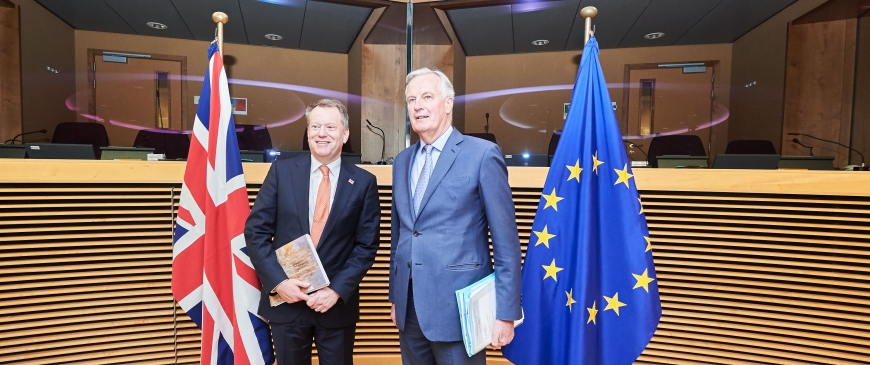
The EU and UK can agree on the scope of a new trade deal, but the devil is in the detail
The EU and the UK have set out what they want their future partnership to look like and the horse trading has begun. Broadly speaking, the two sides are more aligned than not. The British government has accepted the EU’s argument that leaving the single market and customs union means friction at the border, and new procedures and red tape for companies. Below the surface, however, there are some major disagreements including on the role of the European Court of Justice (ECJ), fishing rights, the so-called level playing field provisions relating to environment, labour and state aid rules, and whether the future relationship should be one all-encompassing deal or several mini-agreements. It’s unlikely the EU and the UK will resolve these issues rapidly, but providing the hard December 31st deadline focuses minds later in the year, it is possible to map an eventual route out of the quagmire.
Both the UK and EU want to remove all tariffs and quotas. There is also broad agreement as to the coverage – with both seeking the inclusion of chapters covering issues such as services, transport, intellectual property and telecommunications. Yet if the talks are ever to get to the point where negotiators are discussing this common ground, compromises will need to be found on the stickier issues as I set out in more detail in my report for the Centre for European Reform about the relative case for optimism about the future UK-EU relationship.
On fishing, the opening positions are far apart and emotive. The EU wants to effectively maintain existing conditions and quota shares, while the UK wants to move to a system of yearly negotiations over the total allowable catch and shares, similar to the arrangement the EU has with Norway. The UK has some leverage, but perhaps less than it thinks. About two thirds of the UK’s exported catch goes to the EU, so failure to reach an arrangement could have negative implications for parts of the industry, particularly the shellfish, fish processing and wholesale sectors.
The EU also wants the UK to commit to maintaining similar levels of environmental and labour protections into the future. It also wants those commitments to be enforceable under the dispute settlement mechanism of the broader agreement, and to retain the right to suspend concessions if the UK diverges in ways that give British exporters an unfair competitive advantage over EU-based rivals. The UK, on the other hand, is only prepared to make a general commitment “not to weaken or reduce” the levels of protection afforded by its environment laws, labour laws and standards. And as is the case with other EU FTAs, the UK does not want its labour and environment commitments to be legally binding.
In practice, the EU wants to be able to protect itself, most probably in the form of tariffs, if the UK undercuts it in future. That leaves the UK to consider whether it wants to disagree and accept tariffs from the outset, or agree in order to remove tariffs but accept that some might be reinstated in the unlikely event it diverges in future. It’s worth noting the UK expects to accept an enforceable dispute resolution mechanism in to conclude an FTA with the US.
On subsidies, the EU wants its state aid law to continue to apply to the UK. However, although disputes in this area would be dealt with by an independent arbitration panel, the ECJ would ultimately guide decisions as they would relate to EU law. The British government has agreed in the withdrawal agreement to follow EU state aid rules in Northern Ireland, but it does not want to be subject to them in the rest of the UK. If there is to be an eventual agreement, this is one area where the EU will need to compromise in favour of an approach that could achieve the same outcomes via different means. Disputes could be settled through arbitration, and similar to the proposal on environment and labour rules, interim tariffs could be put in place if government subsidies were perceived to unfairly distort competition.
On the overall structure of the future partnership, the EU wants the various areas of co-operation—from trade to aviation and justice and home affairs--to sit inside a single agreement which included a dispute settlement process. By contrast, the UK wants a series of separate min-agreements and fears that combining everything in one deal would allow the EU to threaten sanctions in one area over dispute in another. The UK’s fears are justified, but it should also appreciate the EU is unlikely to budge on this. The EU has no desire to re-create the unwieldy arrangement it has had with Switzerland, where it has over 100 separate bilateral treaties.
If both sides soften their opening positions, a deal between the UK and EU is possible by the end of the year. In practice, it requires the UK to move a lot, and the EU to move a little, as happened during the withdrawal agreement negotiations. The political dynamics are different this time: the day one disruption of the UK exiting the transition period with a deal is not much different from leaving without one (unless the trade agreement is followed by an actual implementation period). Yet a compromise is possible, if Boris Johnson wants it.
Sam Lowe is a senior research fellow at the Centre for European Reform.
